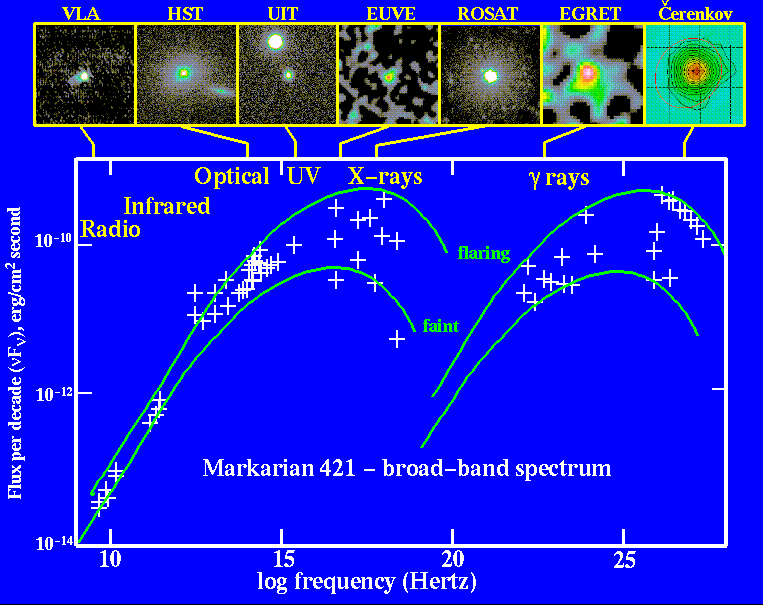
Active nuclei are among the few kinds of astronomical objects which are prominent across the whole electromagnetic spectrum. This montage illustrates the detection of a BL Lacertae object, Markarian 421, from the radio to extreme gamma-ray regimes. The graph shows the energy received per decade of frequency, keyed to images in these wavebands across the top. The spectrum is separated into two parts, believed to be related to each other through the interaction of radiation with high-energy particles either close to a central black hole or in a relativistically-moving jet of particles pointed almost toward our line of sight. The higher-energy bump in the spectrum (prominent in gamma rays) consists of radiation scattered to higher energies by collisions with particles (predominantly electrons) moving close to the speed of light. Measurements are shown when the object was in both bright (flaring) and faint states; the higher-energy part of the spectrum follows suit, giving strong support to this upward scattering picture for its origin. The green curves all have exactly the same shape, shifted to give a schematic match to the spectra at bright and faint levels and for direct and scattered radiation in each case. The observation of high-energy gamma rays was crucial to making this connection; they gamma-ray regime occupies nearly a third of the graph.
The images were produced through a variety of techniques. The radio map is from the Very Large Array, at a wavelength of 20 cm; this particular section is from the FIRST sky-survey project. The optical image was obtained with the Hubble Space Telescope, showing the surrounding host galaxy UGC 6132 and a companion galaxy as well as the brilliant point-like nucleus. The ultraviolet photograph is from the Shuttle-based Ultraviolet Imaging Telescope, working at a wavelength of 1500 Angstroms and showing the foreground A-type star to the northeast of Markarian 421. In the extreme ultraviolet, past the "valley" from 912 to about 100 Angstroms where gas in our own Galaxy absorbs virtually all the light, there is a 1-degree-square image produced from the sky survey carried out by the Extreme Ultraviolet Explorer (EUVE), in this case covering the range from 44-240 Angstroms. The X-ray image is from the ROSAT satellite, sensitive to X-rays of energy 0.5 to 2 keV. Finally, this object is unusual in having a wide range of gamma-ray energies detected, both a space-based one from the EGRET system on the Compton Gamma-Ray Observatory (CGRO) and a ground-based measurement at the highest energies yet observed in astronomy, near 1 TeV (tera-electron-volt, trillion electron volts in U.S. usage) using the Earth's atmosphere as a detector and measuring the extremely short pulses of light produced when such photons interact with the upper atmosphere. These images are all presented in pseudocolor, where a monochrome (black-and-white) image is mapped into various shades of color to make fine shadings more apparent. They cover a large span of areas, from the 35-arcsecond field of the HST image to 10 degrees for the satellite gamma-ray measurement.
This is one of the few objects which have been measured across such a wide wavelength range, most of which is accessible only to spaceborne observatories. For many active galactic nuclei, most of their energy emerges in X-rays or even gamma rays, to which we would remain oblivious if astronomy were still confined to the Earth's surface.
Markarian 421 is located at 11 04 25.6 +38 12 47 (2000 coordinates). The EUVE image is from the all-sky survey, giving 1275 net seconds of exposure here. The object was detected in the highest-energy passband (where foreground absorption is lowest), through the Lexan filter which gives a nominal passband from 44-240 Angstroms. The image covers 1 degree, with 1' pixels, and has been smoothed with a Gaussian of 1.5' standard deviation. The HST image shows the 35" field of the Planetary Camera CCD, in a red-light image of total exposure 240 seconds, courtesy of Meg Urry and Riccardo Scarpa at STScI. The UIT image is a 1430- second exposure in the B1 filter at 1500 Angstroms taken during the Astro-2 mission, provided by Mike Fanelli and the UIT Team. The VLA map is part of the FIRST survey, working at a wavelength of 20 cm, and a region slightly less than 5' square is shown here. The X-ray image of this intense source is from the Position-Sensitive Proportional Counter (PSPC) on board the ROSAT satellite, representing 14 hours of total observation over a two-day period in May 1992, and covers a region about 40 arcminutes square. The EGRET image was obtained by the Compton Gamma-Ray Observatory, and covers a region 10 degrees on a side with a resolution of about 1 degree. The Mt. Hopkins atmospheric-pair telescope data are courtesy of J.Buckley, Washington University.